The AMD Threadripper 2 CPU Review: The 24-Core 2970WX and 12-Core 2920X Tested
by Ian Cutress on October 29, 2018 9:00 AM ESTHEDT Performance: Rendering Tests
Rendering is often a key target for processor workloads, lending itself to a professional environment. It comes in different formats as well, from 3D rendering through rasterization, such as games, or by ray tracing, and invokes the ability of the software to manage meshes, textures, collisions, aliasing, physics (in animations), and discarding unnecessary work. Most renderers offer CPU code paths, while a few use GPUs and select environments use FPGAs or dedicated ASICs. For big studios however, CPUs are still the hardware of choice.
All of our benchmark results can also be found in our benchmark engine, Bench.
Corona 1.3: Performance Render
An advanced performance based renderer for software such as 3ds Max and Cinema 4D, the Corona benchmark renders a generated scene as a standard under its 1.3 software version. Normally the GUI implementation of the benchmark shows the scene being built, and allows the user to upload the result as a ‘time to complete’.
We got in contact with the developer who gave us a command line version of the benchmark that does a direct output of results. Rather than reporting time, we report the average number of rays per second across six runs, as the performance scaling of a result per unit time is typically visually easier to understand.
The Corona benchmark website can be found at https://corona-renderer.com/benchmark
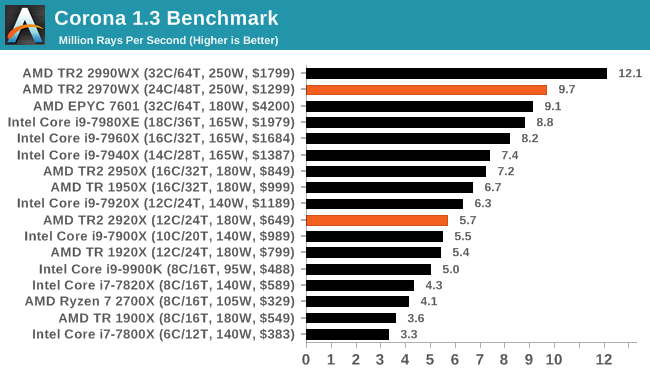
Corona scales well with cores, although memory bandwidth also helps. The 2970WX sits behind the 2990WX amd the 2920X sits behind the 2950X, as expected.
Blender 2.79b: 3D Creation Suite
A high profile rendering tool, Blender is open-source allowing for massive amounts of configurability, and is used by a number of high-profile animation studios worldwide. The organization recently released a Blender benchmark package, a couple of weeks after we had narrowed our Blender test for our new suite, however their test can take over an hour. For our results, we run one of the sub-tests in that suite through the command line - a standard ‘bmw27’ scene in CPU only mode, and measure the time to complete the render.
Blender can be downloaded at https://www.blender.org/download/
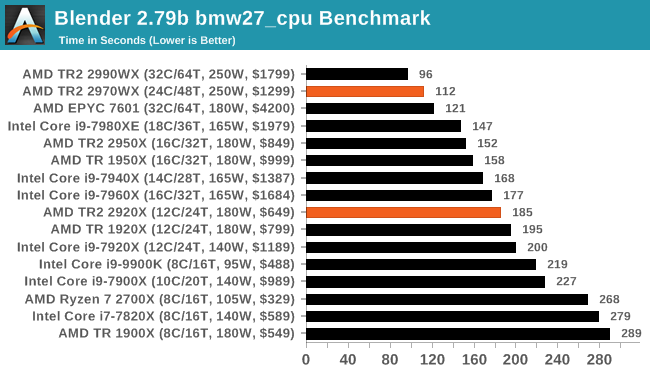
Blender is also another render that likes a mix of cores and memory, being able to put all of the the 2990WX cores to good use. The 2970WX also comes in under two minutes on this test, while the 2920X only just beats the previous generation 1920X.
LuxMark v3.1: LuxRender via Different Code Paths
As stated at the top, there are many different ways to process rendering data: CPU, GPU, Accelerator, and others. On top of that, there are many frameworks and APIs in which to program, depending on how the software will be used. LuxMark, a benchmark developed using the LuxRender engine, offers several different scenes and APIs.

Taken from the Linux Version of LuxMark
In our test, we run the simple ‘Ball’ scene on both the C++ and OpenCL code paths, but in CPU mode. This scene starts with a rough render and slowly improves the quality over two minutes, giving a final result in what is essentially an average ‘kilorays per second’.
It has been pointed out to us that LuxMark is affected by the Spectre/Meltdown patches, so consider this more of a synthetic test of different code paths.
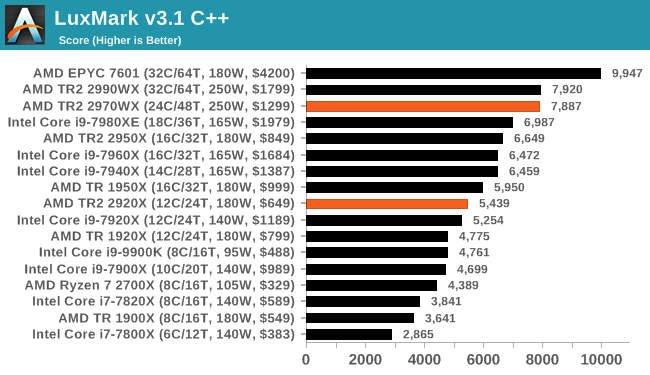
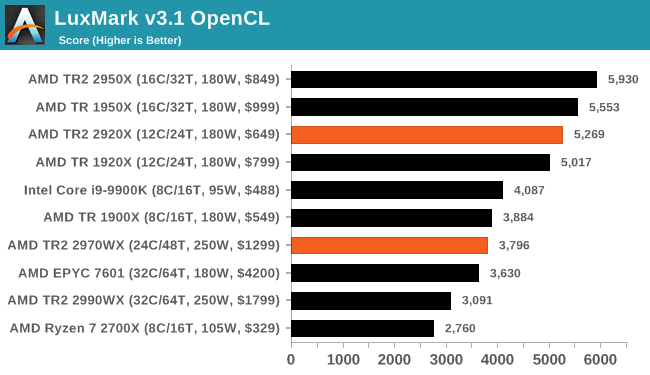
LuxMark in C++ mode seems to be able to take advantage of the extra memory bandwidht on the EPYC platform. Our Skylake-X processors never seem to be able to run the OpenCL model, but we see there are problems above 16 cores in this part of the test.
POV-Ray 3.7.1: Ray Tracing
The Persistence of Vision ray tracing engine is another well-known benchmarking tool, which was in a state of relative hibernation until AMD released its Zen processors, to which suddenly both Intel and AMD were submitting code to the main branch of the open source project. For our test, we use the built-in benchmark for all-cores, called from the command line.
POV-Ray can be downloaded from http://www.povray.org/
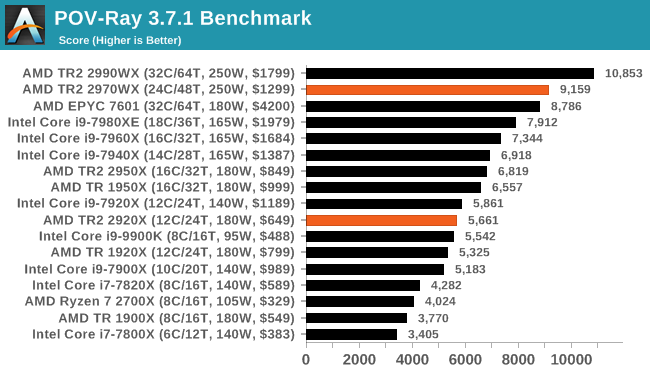


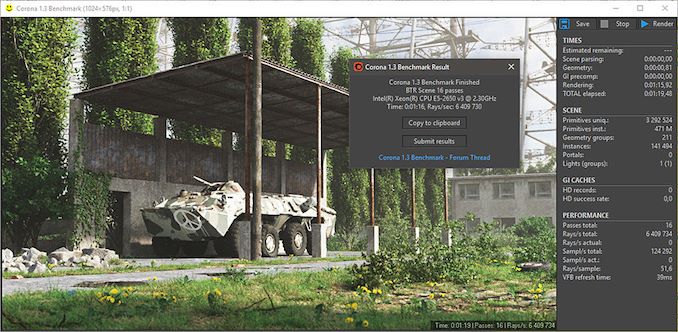








69 Comments
View All Comments
lilmoe - Monday, October 29, 2018 - link
Instead of all the 10+ pages of gaming benchmarks and client side javascript for a platform that most probably won't be used solely for gaming or casual content works, wouldn't it be better to have a suit of server side based benchmarks that are more server oriented? These platforms are becoming very attractive for development and testing of server side applications:- gzip
- pdf conversion
- database transactions
- modern web services
- node.js
etc, etc...
I really see no real value in gaming benchmarks. Not for this platform.
mapesdhs - Monday, October 29, 2018 - link
You might not see the value, but your desire does not reflect that of others, and there's no harm in the data points. You're right though that server side testing would be good, but is this site really the right place for that kind of testing? And from what I've read in the past it can be rather more complicated to run those kinds of tests. AT has a wide audience; they have to think more broadly about to whom they can or should appeal.Howeverm you're wrong in one regard, the cost of the 12-core inparticular to me looks like a rather nice alternative for those wanting decent gaming performance at 1440p or higher, but also good productivity potential. Given its cost, seems like an ideal streaming/gaming/productivity all-rounder to me.
DominionSeraph - Monday, October 29, 2018 - link
i9 9900k would be a better choice. It splits the heavily multithreaded benchmarks with the 12 core, is $160 cheaper for the CPU, and doesn't require a $400 motherboard.eva02langley - Tuesday, October 30, 2018 - link
Techspot takes.''We didn’t have time to retest the Core i9-7900X, but I can assure you with the data we have on hand the 2920X also dominates that part as well, mostly because the 10-core Intel CPU costs over 40% more. That just leaves the 9900K, and honestly, if productivity tasks are the focus then we believe the 2920X is the smarter buy. It will end up costing a little more overall but for applications that utilize the 12-core Threadripper CPU well, a heavily overclocked 9900K will melt trying to keep up.''
TheinsanegamerN - Tuesday, October 30, 2018 - link
The i9 9900k would spend its time melting down under water cooling attempting to keep up, while costing more after the cooling solution then threadripper costs.Icehawk - Monday, October 29, 2018 - link
Please provide your full Handbrake settings (IMO it should be linked in the article), you get about 3x faster encoding than I do at “Fast, Main, 3500kbs”. I’d love to triple my throughput.mapesdhs - Monday, October 29, 2018 - link
It's amazing how some options in Handbrake can cut performane in half. I've been meddling with it a lot today, certain filters can really slow things down.rony_ph - Monday, October 29, 2018 - link
Hello,With all these threadripper tests, how come we never see any reference or use case scenarios for Virtualization. Those CPUs with with this amount of cores, can easily be used to host multiple VMs, etc... yet all the testing is mainly on Office Apps, Gaming and 3D but never on virtualization and the advantage of having such a CPU would do for these scenarios... I'm certain that there are tons of people using those chips to run VMware & Hyper-V, etc...
schujj07 - Monday, October 29, 2018 - link
You wouldn't use these for VMware or Hyper-V to run mission critical VMs. You might use VMware Workstation with them to run Sandbox systems.rony_ph - Monday, October 29, 2018 - link
Never mentioned mission critical systems. As hone or power user. A cpu like 2990w or 2970w will easily let you have 60+ vms running in parallel to do your own testing and lab environment. While buying an equivalent from intel for same price range (not talking about Xeon) wont let u make half as much VMs. You can even probably run an azure stack on it for testing purposes. So the use of such a CPU is huge for an IT Pro for instance.